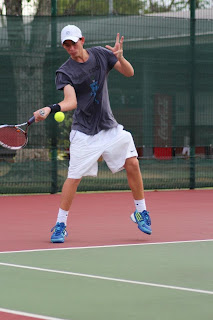A COMPLETE SYSTEM OF ON-COURT MOVEMENT
Tennis today
is played at a much faster pace than ever before. The demands on a player to
move faster place tremendous importance on fitness, speed, and anticipation. I
teach a system of movement that involves all three of those requirements and
some more.
There are 3 main
parts I try to teach my students when working on court anticipation and
movement:
1. OBSERVATION
2. REACTION
3. RECOVERY
Here are the 3
parts explained in more detail -
OBSERVATION
In today's
fast-paced game, players must anticipate where the
ball will go to some degree. Observation is the most critical aspect of
anticipating well. Anticipation requires players to read their opponent's
preferences and swing patterns and get a quick read on the ball's direction.
It's then time to move!
I ask my
players to observe the moment of contact at the other end of the court. The
moment the opponent makes contact with the ball should be monitored closely because
once the ball has been struck, we can't afford to waste a second.
REACTION
Once my students have started observing the
opponent's contact, I have them create a 'Skip Check.' The skip check is a soft
lift off the ground. You see this skip check with good returners of the serve; without it, the quick movements to the left or the right are impossible. Today,
the pace of the groundstroke game demands the same explosiveness as the return
of serve, and therefore we must add the skip check to our general baseline game.
The skip check should be synchronized at the exact moment of contact at the
other end of the court.
This links
observation to action. Without action, the observation gets lazy, and the
player sees no reason to use time or effort to watch for the opponent's moment
of contact.
Action (the
skip check) also needs a function, or it's meaningless. The purpose of the
skip check is to create an explosive start to the movement on landing if required.
While the
player is airborne, the ball starts its path back from the opponent's racquet, and we would now know where we need to run for the next stroke. This is the key
to the skip check; you are about to land on the ground knowing which direction
you move next. From the landing, the direction to move can now be anticipated, and through pre-innovation, the movement can be explosive and accurate.
We have now added
an action to our observation, making us much quicker on-court.
RECOVERY
We have
covered the movement to the ball, and this will undoubtedly improve once the skip
check becomes calibrated to the opponent's contact and the two become
instinctual.
However, if
you leave your player with just observation and reaction skills, you haven't
done them justice. The rally lasts a lot longer today, and players are
expected to get many more balls back during the average rally. They need a way
to recover for the next ball.
Recovery needs
to involve the best way to run at full speed to a wide ball and return from that
position to cover the court as best you can.
The way to achieve
this is by 'Flipping the Spine.' FTS means that you enter the strike zone with
your spine in an optimal position, create the Line at the moment of contact and
position the spine in an optimal way to recover back to a central place on the
court.
In this first
picture, you see Rafi moving toward the wide ball at speed. His spine is angled towards the side fence.
The 2nd
picture, the contact, shows Rafi creating the Line. The Line is the optimal
point of balance and energy transfer from the ground (through
Rafi's right toe).
The 3rd
picture shows Rafi already recovered from the stroke. He has 'flipped his spine' back to begin his
movement back toward the center of the court. This flipping of the spine is
the essence of recovering quickly to the vacant court.
Performed together, this
system of Observation, Reaction, and Recovery has all the elements a player
needs for on-court movement in today's fast-paced game.





%20copy.png)


Very interesting :-) I like the part of the skip check aka split step as the action following the observation of the ball being hit by the opponent.
ReplyDeleteThanks CCH, It's simple stuff but putting it together in a system like this helps the player see the results on-court faster also. Thanks for your comments
DeleteVery useful!
ReplyDeleteThank you Rampradeep. Happy if you can use this
Delete